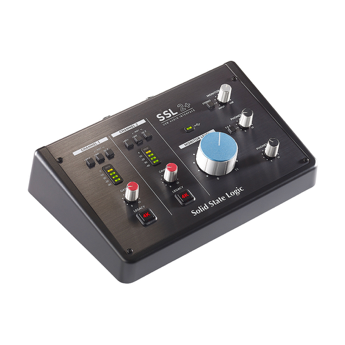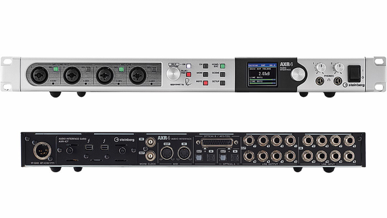There‘s a moment in every musician’s career when investing in recording equipment becomes necessary. However, there’s a difference between buying music instruments and a recording audio interface, as the latter requires more technical knowledge, patience, and research to choose and set up.
An audio interface is essential gear for most music-makers: it can define your sound as much as a Digital Audio Workstation (or DAW software) does, and choosing the right interface will give you all the tools you need to be creative and prolific in music production.
This article will analyze the different types of audio interfaces available in the market, what you might need an audio interface for, and clarify which one is the right audio interface for you, depending on your needs.
In a nutshell, audio interfaces connect your musical instruments to your laptop or tablet, allowing you to record multiple channels with recording software. They are the foundation to recording studios of all sizes, from the amateur home studios to Abbey Road.
The built in sound cards of the average laptop are pretty basic, which means the quality of the recorded sounds will be, at the very least, inadequate if you wish to record professional music. Furthermore, recording multiple channels simultaneously is not an option with your laptop’s sound card.
Audio interfaces are also ideal if you make music using all sorts of musical instruments. Even on a basic audio interface, you’ll find various audio inputs and outputs and MIDI connectivity that you can use to connect your gear to it.
In some cases, you’ll need an audio interface with speaker outputs to connect hi fi speakers or studio monitors to your computer’s audio output.
If you aren’t concerned about studio monitors. Many audio interfaces also offer at least one higher quality headphone output (if not dual headphone outputs). Audio interfaces also offer greater control over the built in headphone amps and an easy way to work with headphone mixes.
An audio interface will often include phantom power as well. Some microphones require an external power source in order to operate. Frequently a condenser microphone will require phantom power. Luckily you’ll find that most mixers and audio interfaces will include this feature. Although it’s worth noting, that only some microphones require phantom power. With some mics, you need to be extra careful. With some ribbon mics, it’s possible that phantom power can actually cause damage or even destroy the mic.
An audio interface takes the sound you’re producing (be it from a digital MIDI keyboard, an actual piano, or a guitar) and converts it to a format your laptop can recognize and record. Much like how a USB microphone can convert the audio signal from a USB mic to digital, an audio interface can do that with more than one source. Audio conversions happen on all input/output channels you’re using to record your music, and each note gets converted into digital signals your device can identify and capture using your DAW.
Audio interfaces have become more and more necessary with the increasing popularity of digital audio recording. When all the recording equipment was strictly analog, there was no need to convert analog input signal to digital audio: the sounds were simply transferred to a mixing desk and recorded on tape.
While recording an album in an analog recording studio was (and still is) extraordinarily expensive, today you can build your own digital recording studio with a few hundred dollars and achieve professional quality audio. If that’s what you’re planning to do, you won’t be able to rely on your computer’s sound card and the audio interface is the first and most important piece of gear you’ll have to buy.
Before buying a new audio interface, you need to make sure it’s compatible with your current audio gear and computer. There are many audio interface connection types but most interfaces today are USB audio interfaces, which are easy to set up, and a USB port is a common feature on most laptops. Although if you’re using your USB ports for additional instruments, make sure to keep one port open for your audio interface.
Have you ever heard of FireWire connectivity? Back in the day, it was the standard connection type for most audio and video interfaces as it was more reliable than USB. Now it’s almost impossible to find a FireWire interface, primarily because most laptops don’t come with FireWire ports anymore. However, if your computer does have a FireWire port, I suggest you give it a try: USB connectivity took years to reach the FireWire’s quality for a reason. For over ten years, I recorded using an Edirol FA-66 FireWire, and I absolutely loved it.
PCIe is a card-based interface that requires more technical knowledge but provides professional results with close-to-zero latency. However, they’re also costly compared to the previous two options.
If you’re a Mac user, you’ll also find thunderbolt audio interfaces provide a fast and effective connection. Due to exclusivity within the platform, these will only work with Apple computers.
Depending on whether you want to kickstart your songwriting career or upgrade your existing professional recording studio, there are many audio interfaces to choose from. Even though budget is an essential aspect to consider, the most critical factor for audio interfaces is defining what you need it for.
A big question is how many inputs will you need. Choosing the correct Input/Output configuration is a fundamental step. For example, if you’re a songwriter, one or two channels will likely be the best audio interface for all your recording needs (one channel to record voice, the other to record guitar). On the other hand, if you’re playing in a band and your demanding drummer wants to have 15 microphones surrounding their full drum kit each with each recorded to separate tracks. Then you’ll probably need at least 20 or more xlr inputs to record your next album.
For this article, I chose three audio interfaces that should meet the demands of most creatives: starting from the most affordable one and ending with an ultra-pro audio interface.
This Scarlett series audio interface offers undoubtedly the best entry-level audio interfaces you can find. Crystal clear production quality audio, extremely low latency, and an intuitive setup: the Scarlett 2i2 has it all, with studio quality recordings that can easily compete with more expensive interfaces.

The most affordable hardware the legendary manufacturer SSL has ever produced, the SSL 2+ audio interface features an incredible audio quality for the price, with a unique, clean mic preamp gain that makes it ideal for recording quiet sources or spoken word.

The Thunderbolt 2 connectivity guarantees zero latency monitoring and the best audio quality you can expect from an audio interface. With its 28 inputs and 24 outputs, the Steinberg AXR4 is the perfect choice for recording industry professional producers and engineers.
Now that you can answer the question: what is an audio interface? The next crucial question you have to ask yourself before buying an audio interface is: what do I need an audio interface for? For instance, moving beyond your computer’s sound card and investing in an interface with more inputs and outputs may be unnecessary if you’re a songwriter. If this is your first audio interface, choose one that satisfies your recording and software mixing needs and is easy to use with your DAW software: you can always upgrade to a new one when the time comes.
Next, you should always consider the connectivity and ensure your laptop or tablet is compatible with the interface you’re interested in. Finally, consider your budget. There are affordable options that offer incredible results, so make sure you do your research before investing in a piece of equipment that won’t guarantee the sound quality you look for in the long term.
When it comes to choosing a new audio interface, it may feel overwhelming to go over all the options available in the market and the technical specs of each device. However, choosing the right interface will give you the tranquillity and creative freedom you need to create your best tracks, and give you access to a whole new universe of sounds.